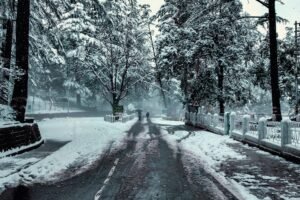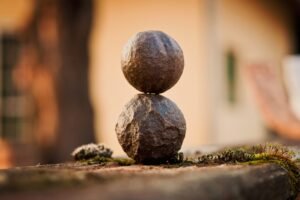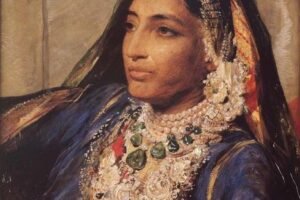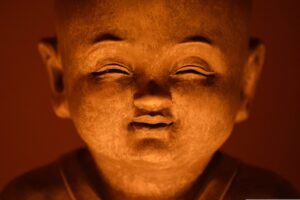The late nineteenth century witnessed the emergence of three prominent men in the Sikh community who were destined to play a significant role in shaping the course of events for years to come. They were Sunder Singh Majithia, Trilochan Singh and Bhai Vir Singh. While all three excelled in different fields, they worked in complete harmony for the attainment of their common objective of bringing about a renaissance in the Sikh community. Among themselves they formed, so to say, a durable triangle the three sides of which represented the best in Sikh politics, economy and literature.
Eldest of the trio Bhai Vir Singh was born on 5th December 1872, in a family which had deep historical and scholarly roots. The historical importance of the family goes to the middle of the eighteenth century when Diwan Kaura Mal earned laurels because of their heroic role in the battle of Ram Rauni. Bhai Vir Singh’s father Dr Charan Singh was not only a popular medical practitioner of his times but had also earned a great name in the world of letters. After having been initiated in traditional education, young Vir Singh got his grounding in Sikh literature under the guidance of his maternal grandfather Giani Hazara Singh. Later Vir Singh joined the Church Mission
High School at Amritsar, from where he passed his matriculation examination in 1891. With inherent literary genius and family connections, Vir Singh could have easily taken to Braj, Sanskrit or Hindi, as was the fashion in those days. Making a departure from the tradition, he decided to work for the promotion of the Punjabi language and the Gurmukhi script, which till then did not get the status it deserved. It was the pioneering effort of Bhai Vir Singh that brought much-needed respect to the so-called Gramin bhasha. He can be rightly called the father of modern Punjabi literature because no other litterateur has written and published so much in this language.
Bhai Vir Singh was born at a time when there was a growing religiopolitical awakening and movements like the Singh Sabha and the Arya Samaj were greatly swaying young minds. He was both, the product of the Singh Sabha movement as also its guiding spirit. It is a strange coincidence that Vir Singh was born a year before the launching of the Singh Sabha Movement and became one of its chief spokesmen. What distinguishes Bhai Vir Singh from his other contemporaries is the fact that rather than entering into any political controversy or the Arya-Singh Sabha polemics he decided to work for the spiritual rejuvenation of his community. This he did by providing inspiration from the historical past.
Through the efforts of Bhai Vir Singh and other traditional intellectuals the Singh Sabha soon became a force to reckon with. It not only created a new self-awareness and confidence among the Sikhs but also made the members of the community realize their backwardness in various fields. Bhai Vir Singh thought that the only way to take his community out of the prevalent mess was through the propagation of the high ideals and institutions of the Sikh faith and this he did through his novels, poems and other literary works.
With a view to propagating Sikh ideals and institutions Bha i Vir Sing h sta r ted a Punjabi weekly, the Khalsa Samachar. In spite of the high mortality rate among Punjabi papers, the Khalsa Samachar has not only been able to survive but has completed a centenary of its foundation happily coinciding with the tercentenary of the creation of the Khalsa in 1999.
Bhai Vir Singh’s devotion to humanity expressed itself in various ways. His primary source of contact with humanity was through books and he established the Khalsa Tract Society and the Wazir Hind Press. He was also instrumental in establishing an orphanage at Amritsar. He organized the Sikh Educational Committee for the propagation of education in Punjab. The initiative was also taken in creating a movement for the uplift of the so-called ‘Untouchables’. Besides starting an institution for the blind at Amritsar, he also established a free Homeopathic Hospital at the same place. In spite of being involved in so many projects, he preferred to remain in the background. His books never carried his name and he liked the anonymity. It was only in the later years of his humble and unassuming life that his services to the literary arts, philosophy, religion and humanity became widely known.
During his own lifetime, Bhai Vir Singh greatly endeared himself to the budding poets, writers and intellectuals. It was the healing touch of Bhai Sahib which reclaimed Prof. Puran Singh back to the Sikh Faith. Bhai Vir Singh was especially fond of Lala Dhani Ram Chatrik. Paying his tribute on the eve of Bhai Vir Singh’s centenary celebration Lala Dhani Ram Chatrik fondly recalled how proud he felt in being called Kaka, (a pet name usually used for a young boy) by Bhai Sahib. His love for another Punjabi poet Khuda Dad was equally overwhelming. When after the partition of India the Punjabi Language Department decided to honour Bhai Vir Singh, he not only declined the offer but also pleaded that the same be conferred either on Khuda Dad or Lala Dhani Ram Chatrik.
A spiritual and elevated soul, Bhai Vir Singh shunned worldly publicity and glamour. He hardly attended any functions or made any public speeches. When persuaded to make a speech on the eve of the Sikh Educational Conference in Bombay, where he was to be presented with an Abhinandan Granth, the only words he uttered were Wahe Guru Ji Ka Khalsa, Wahe Guru Ji Ki Fateh and expressed his gratitude by quoting from Gurbani:
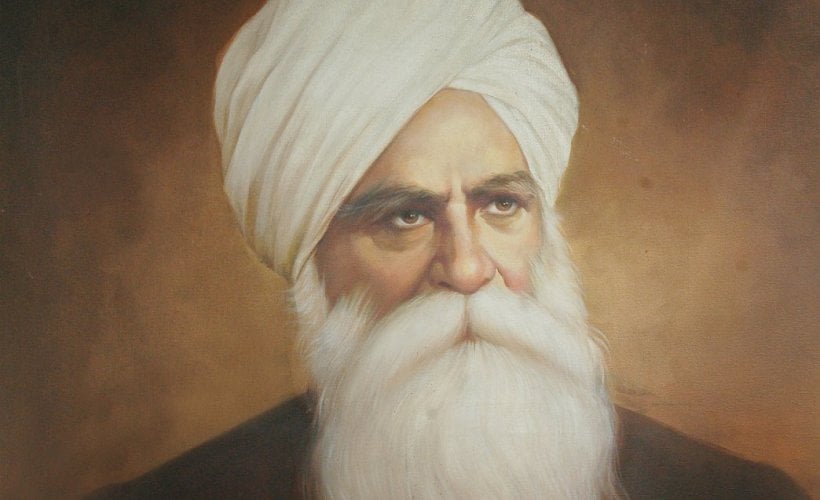
Hum rulte phirte koee baat na poochhta Gur Satgur sang keere hum thaape (167)
(I was nobody; no one cared for me,
I am honoured because of Satguru’s grace.)
Again when he was honoured with the Padma Bhushan by the Government of India, he declined to participate in the ceremony
at the Rashtrapati Bhawan. Later when the award was presented to him at Amritsar, he suggested the same be placed before the holy Guru Granth Sahib.
Though Bhai Vir Singh did not actively participate in the country’s struggle for freedom he had clearly provided inspiration to the popular movements through his writings. It was because of this that D. Patrie, a senior intelligence official described him as one of the most dangerous persons in Punjab. In Secret Memorandum on Recent Developments in Sikh Politics, published in 1911, this is how D. Patrie describes Bhai Vir Singh:
“He (Vir Singh) is the Editor and Manager of the Khalsa Samachar, a Gurmukhi journal, which is published in Amritsar. Vir Singh is mentioned by many sources as a leading figure in the Sikh revival and as disloyal to the core. The same opinion is entertained of him by local officer…. He (Vir Singh) may safely be regarded as a zealous neo-Sikh and thoroughly anti-British”.
While the C.I.D. officials labelled him as anti-British, the nationalist elements described him as a supporter of British rule. Bhai Sahib believed in strengthening the spiritual heritage rather than indulging in factional politics. For this, he also developed differences with some of the Sikh leaders of his time. Master Tara Singh criticized him for his indifference to Sikh politics but later sent a letter of apology from Sitapur Jail in 1949. In the letter, Masterji made a fervent appeal to Bhai Sahib to forgive him for the past criticism and requested him for providing guidance to the community at the crossroads. In his typical reply, Bhai Sahib wrote back that he was nobody to forgive. It was the Almighty to pardon them for their wrongs and sent him a set of Panj Granthi Steek to get spiritual sustenance.
Regarded as Bhai Gurdas of the 20th century, Harindra Nath Chattopadhyaya called him the “sixth river in the land of five rivers”. East Punjab University conferred a degree of
Doctor of Oriental Learning on him. His most important works are Sri Kalgidhar Chamatkar, Sri Guru Nanak Chamatkar, Asht Gur Chamatkar, Baba Naudh Singh and Meray Saeeyan Jeeo. One of his earliest writings Sundri is a landmark in modern Punjabi literature. Some critics call it the first novel of the Punjabi language.
In his poem Banakshe De Phull, he writes:
Meree chippe rehan di chaah chhip tur jaan, mein neevan ugeya
shows the great humility of the versatile writer.
His poem Ichchabal stresses that those, who love God don’t sit idle and are always on the move:
Nehou wale naina dinai raat paia vehinday oh araam kar nahee behinday
Ichchabal also depicts his deep-rooted love for nature. A Gurdwara at Gulmarg in Kashmir valley bears testimony to this.
When mandirs (temples) were being demolished to make way for masjids (mosques), his heart cried out and he composed heart-touching Mandir Maar Tand De.
Bhai Vir Singh was a versatile thinker. He was a poet, novelist, playwright, historical researcher, critic and spiritualist all in one. He also edited and published Praacheen Panth Prakash and Janamsakhi, the life story of Guru Nanak. He was a spiritualist to the core:
Supne vich tusee milai asanoo assan dhaa galwakdee paaee, Nira noor tusee hath naa aayee saadi kambdee rahee kalayee.
| When he was honored with the Padma Bhushan by the Government of India, he declined to participate in the ceremony at the Rashtrapati Bhawan. Later when the Award was presented to him at Amritsar, he suggested the same be placed before the holy Guru Granth Sahib. |
He found spiritual lessons in the objects of nature. A Keekar tree is a symbol of the divine seeker, who must face the barbs and arrows of the worldly people. The poet’s choice of plants in his house at Amritsar tells us a great deal about him as a person. The sprawling house, with rare plants and herbs, shows the rich taste and high thinking of Bhai Vir Singh and his love for nature. A casual visitor gets astounded to find big trees including Cheeku, Cheel, Neem, Walnut, Mango, Litchi, Kachnaar, Jack Fruit, Rosary, Firangipani, Karhi Patta, Simbal, Berry Jujube, Plum, Banana and Dheon in the house. Four bouquets taken from the garden of Bhai Vir Singh’s house are taken to the Golden Temple every morning by the octogenarian Bibi Amrit Kaur, who lives in the house.
Interestingly, Lawrence Road, where his house is situated, was named after Bhai Vir Singh more than a decade ago. The palatial house, spread over five acres, has preserved almost all the belongings of the greatest Punjabi writer even more than five decades after his death. The old and unique hand-pump installed by Bhai Vir Singh himself is another landmark of the house. Bhai Vir Singh himself installed the old idol of Lord Buddha in a beautiful corner of the house.
The hilly hut-type room (which seems replica of Sri Hemkunt Sahib) constructed specially for the holy Guru Granth Sahib shows his unflinching faith in The Almighty.
Ujjal Singh and Sant Teja Singh were instrumental in converting this house into a memorial after he merged with the Divine Light in 1957. This picturesque residence turned memorial is surrounded by lush green spacious gardens and an orchard, which should have been a pilgrimage centre for many, but is visited by a few, as most of the residents of the city are not even aware of the rich heritage of Punjabi literature housed here. Unlike the residence of Bhai Vir Singh, the half-timbered house, where William Shakespeare was born in 1564, continues to be the most cherished historic place and is a frequently visited tourist centre. The stunning house of Bhai Vir Singh could similarly be opened to the public.
At a time, when the Sikh community and leadership are again at a crossroads, we need men of Bhai Vir Singh’s stature to show us the right path.
Hemkunt Sahib connection
Bhai Vir Singh was instrumental in locating the site of Gurdwara Hemkunt Sahib. Pandit Tara Singh Narottam, a 19th Century Nirmala scholar, was the first Sikh to trace the geographical location of Hemkunt. He wrote of Hemkunt as one of the 508 Sikh shrines, he described in Sri Gur Tirath Sangrah (first published in 1884).
Later Bhai Vir Singh was instrumental in developing Hemkunt after it had been, in a sense, rediscovered by another Sikh in search of the Guru’s Tap Asthan. Sohan Singh was a retired Granthi from the Indian army, who was working in a Gurdwara in Tehri Garhwal. In 1932, he read the description of Hemkunt in Bhai Vir Singh’s Sri Kalgidhar Chamatkar (1929). Bhai Vir Singh’s description was so compelling that on reading it, Sohan Singh resolved to search for the place, where Guru Gobind Singh had meditated.
Revealing Baru Sahib
Bhai Vir Singh was also instrumental in revealing to the world a hitherto unknown Tapo Bhoomi, Baru Sahib, the Valley of Divine Peace. Sant Teja Singh approached the Bhai Sahib in 1955-56 at Dehradun, to discuss with him the vision of Sant Attar Singh Mastuana Wale to establish a Braham Vidya Kendra (a university of spiritual brotherhood). He suggested a place 65 kilometres off Solan in the lap of the Himalayas ensconced in seven hills at village Baru, where Rishis, Munis, Pandavas, Rishi Gautam and the likes have meditated on the Divine Name since times immemorial. The place has also been visited by Guru Gobind Singh, when he was travelling through the state of Nahan with Raja Medani Prasad. Bhai Vir Singh was so impressed that he suggested Sant Teja Singh immediately put the vision of Sant Attar Singh into practice and go ahead with the job. Although with his advanced age and failing health, Bhai Vir Singh could not visit Baru Sahib in 1956 when this Tapo Bhoomi came into existence, he had his tacit approval for the project.


